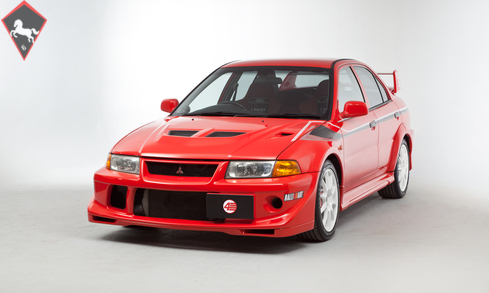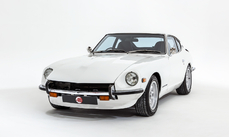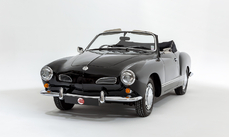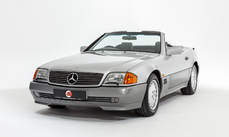Mitsubishi Lancer Evo VI TME 2000
Allgemeine Beschreibung :
Model History
The Lancer Evolution was a high performance sports car manufactured by Mitsubishi Motors and based on the standard Lancer. There have been ten official versions to date, with a Roman numeral designating each model. All use two-litre turbocharged engines and all-wheel drive systems.
The Evolution was originally intended only for Japanese markets, but demand on the "grey import" market led the Evolution series to be offered through Ralliart dealer networks in the United Kingdom and in various European markets from around 1998. Japanese-spec cars were limited by a gentlemen's agreement to advertise no more than 276hp, a mark already reached by Evolution IV. Therefore, each subsequent version has unofficially evolved above the advertised power figures, with the Japanese-spec Evolution IX reaching an alleged output of around 317hp.
The Evolution VI was produced from January 1999 until March 2001. The improvements over its predecessor mainly focused on cooling and engine durability. It received a larger intercooler, larger oil cooler, and new pistons. The Evolution VI received new bodywork yet again, with the most easily noticeable change being within the front bumper where the huge fog lights were reduced in size and moved to the corners for better airflow.
In 1999 the Tommi Makinen Edition was released. It featured a different front bumper, red and black Recaro seats embossed with the Tommi Makinen logo, 17-inch white Enkei wheels, a red-stitched leather Momo steering wheel and shift knob, a titanium turbine that spooled up more quickly, front upper strut brace, lowered ride height (with tarmac stages in mind), and a quicker steering ratio, among other things. The car is sometimes referred to as an Evolution 6.5, or TME for short.
The Tommi Makinen Edition was only available in Scotia White, Satellite Silver, Pyrenees Black, Canal Blue, and Passion Red (the only colour scheme available with the Works stripes and decals kit). Out of all the colours, red is considered to be the most collectable with values of such cars increasing year on year. In total there were 2,021 GSR and just 678 RS lightweight variants. It is believed that only 212 cars were produced in red with the Special Colour Package.
Equipment
Special Colour Pack, TME embroidered Recaro front seats, 17-inch Enkei wheels in white, Front and side airdams, Twin-wing adjustable rear spoiler with high-mount stop lamp, Power steering, Momo leather steering wheel with red stitching, Leather gearknob and gaiter with red stitching, Brembo brakes, Colour-keyed door mirrors, Driver’s and front passenger’s SRS airbags, Automatic air conditioning, Electric windows front and rear, Remote central locking system, Rear centre armrest, Cup holders, Spare wheel, Jack and wheel brace, Sports suspension, Atmospheric blow-off valve, Boost gauge with control unit, DIN gauges, Turbo timer, Spare key.
Exterior
Still sporting its factory stripes the Passion Red exterior of this low mileage TME presents to an excellent standard throughout. The paintwork is free from any of the common fading issues, and with barely a stone chip to the front end there are almost no marks to report, although a perfectionist may note a little patina to the original decals.
Even with its “tarmac stage” ride height the TME’s aerodynamic bodykit is without any road rash, and the rear arch seals retain a fresh appearance having been renewed not too long ago. Better still, both the body and underside remain in wonderful rust-free condition. The car was supplied new in Japan and so, having only recently landed in the UK, has spent its life on salt-free roads since new.
Interior
The rally-inspired theme continues to the cabin. The supportive Recaro seats are upholstered in distinctive red cloth and black velour, finished with special ‘T. Makinen Edition’ embroidery. The deep bolsters of this example are pleasingly free from any major wear or bobbling to the fabric. The rear seats are also unmarked, and the carpets are protected in the foot-wells by a set of genuine Mitsubishi overmats.
Glancing across the dash you’ll find original details such as the Momo steering wheel, leather gear knob and red-stitched gaiter all still in place. Suitable gauges are installed above the radio ensuring the driver is kept well informed about important temperatures/pressures. The cabin also boasts a dash-mounted boost gauge.
ENGINE & TRANSMISSION
The engine bay of this example retains a clean appearance with no signs of any corrosion, damage or poor repair. There are a handful of performance parts in place, but rest assured that the car still operates smoothly at low speeds before launching into ferocious acceleration at anything above 4,000 rpm. The sensible addition of a turbo timer automatically executes the cool-down period required to prevent premature turbo wear and failure.
With just 31k miles to its name the five-speed manual gearbox feels tight and precise, and the four-wheel-drive system provides enough confidence to power though corners at speed. Despite its high-performance credentials, this Evo VI still drives with typical Japanese-car ease. A full service and timing belt change has recently been carried out at Mitsubishi for the new keeper’s peace of mind. The work was undertaken at Wiltshire & Sons in Farnham.
WHEELS, TYRES & BRAKES
The Evo VI sits on its original set of 17-inch Enkei wheels in white. All four alloys are in excellent condition presenting with almost no wear to speak of. They are correctly finished with Enkei/Ralliart decals and black Mitsubishi centre caps. All four wheels are wrapped in Goodyear Eagle F1 tyres. Between the spokes the Brembo calipers look great in red with no signs of any lacquer peel or age-related wear.
History File
The Evo 6.5 was supplied new in Yokohama, Japan, where it was first registered in March 2000. This superb and rare example is complemented by a great maintenance record within the dealer-supplied service booklet. It has recently returned from Mitsubishi in Farnham following a health check, full service and timing belt change for the new keeper’s peace of mind. The original Mitsubishi document holder is also present and correct with handbooks.
http://www.4starclassics.com/for-sale/mitsubishi-lancer-evo-vi-tme-for-sale/
2000 Mitsubishi Lancer Evo VI TME is listed verkauft on ClassicDigest in Kingsley by 4 Star Classics for £39995.
Fakten der Auto
Karosserietyp : Auto Marke : Mitsubishi Modell : Lancer Ausführung : Evo VI TME Hubraum : 2.0 Modelljahr : 2000 Karosstyp : Pick up Lage : Hampshire
Verkauft
Angaben Zum Verkäufer
Verkauft
People who viewed this Mitsubishi Lancer also viewed similar Mitsubishi listed at ClassicDigest
Other cars listed for sale by this dealer
über Mitsubishi
Mitsubishi: Eine Reise durch die Geschichte (bis in die 1980er Jahre)1. Frühe Anfänge:
Gründung: Mitsubishis Wurzeln reichen zurück zur Gründung einer Schifffahrtsfirma durch Yataro Iwasaki im Jahr 1870.
Diversifizierung: Das Unternehmen expandierte in den Bergbau, den Schiffbau und andere Branchen, was die Grundlage für die Mitsubishi Group bildete.
2. Erste Automobilunternehmungen:
Erste Automobilproduktion: Mitsubishi wagte sich im frühen 20. Jahrhundert in die Automobilproduktion.
Modell-A: Im Jahr 1917 führte Mitsubishi sein erstes Serienfahrzeug, das Modell-A, ein, Japans erstes Serienautomobil.
3. Nachkriegsära:
Umstrukturierung: Nach dem Zweiten Weltkrieg stand Mitsubishi vor Herausforderungen, durchlief jedoch eine Umstrukturierung und nahm die Automobilproduktion wieder auf.
Produktion von Jeeps: Anfangs konzentrierte sich Mitsubishi auf die Produktion von Jeeps und trug erheblich zur Wiederbelebung der japanischen Automobilindustrie bei.
4. Meilenstein-Modelle:
Mitsubishi 500: 1960 eingeführt, war der Mitsubishi 500 ein Kompaktfahrzeug, das dazu beitrug, kleinere Fahrzeuge in Japan populär zu machen.
Mitsubishi Colt 600: 1962 herausgebracht, war der Colt 600 ein Kleinwagen, der dazu beitrug, Mitsubishis Präsenz auf dem Automobilmarkt zu stärken.
5. Globale Expansion und die 1970er Jahre:
Partnerschaften: Mitsubishi schloss Partnerschaften mit internationalen Automobilherstellern und erweiterte damit seinen Einfluss über Japan hinaus.
Galant und Lancer: Modelle wie der Galant und der Lancer gewannen in den 1970er Jahren an Popularität und zeigten Mitsubishis Engagement für Innovation und Leistung.
6. Technologische Fortschritte:
Mitsubishi Astron-Motor: In den 1970er Jahren eingeführt, wurde der Astron-Motor zum Markenzeichen von Mitsubishi-Fahrzeugen und war bekannt für seine Langlebigkeit und Effizienz.
7. Höhepunkt der 1980er Jahre:
Mitsubishi Pajero: Anfang der 1980er Jahre eingeführt, markierte der Pajero (Montero in einigen Märkten) Mitsubishis Einstieg in das SUV-Segment und wurde ein globaler Erfolg.
Starion: Der Starion, Mitte der 1980er Jahre eingeführt, war ein Sportwagen, der Mitsubishis Leistungsfähigkeit demonstrierte.
8. Klassische Modelle von Mitsubishi der 1980er Jahre:
Mitsubishi Delica: Der Delica, erstmals in den 1960er Jahren eingeführt, gewann in den 1980er Jahren an Popularität und war ein vielseitiger Van in verschiedenen Konfigurationen.
Mitsubishi Mighty Max: Dieser kompakte Pickup-Truck war bekannt für seine Robustheit und Praktikabilität.
Mitsubishi Mirage: Der Mirage, in Hatchback- und Limousinen-Versionen erhältlich, wurde aufgrund seiner Kraftstoffeffizienz und Zuverlässigkeit beliebt.
Mitsubishis Reise durch die 1980er Jahre spiegelt ihre Entwicklung von einem vielfältigen Konglomerat zu einem bedeutenden Akteur in der globalen Automobilindustrie wider. Das Jahrzehnt brachte die Einführung von ikonischen Modellen mit sich, die Mitsubishis Ruf für Innovation und Leistung stärkten.







